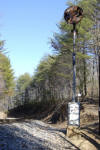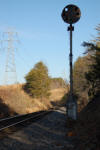
In General
Conversion to Color
Additional Information
Signal Variations
Upper Head
Lower Head
Signal Mounting
Rulebook Aspects
Additional Pictures
RAILROAD SIGNALS HOME
The Norfolk and Western adopted Pennsy Position Light Signals when they replaced/updated their semaphores. This was due to their partial ownership by the Pennsy. The picture at the top of the page was taken at Railwalk in Roanoke Virginia, where they have done an excellent job of showing to the public what trains are all about!
The technical description for N&W signals is the same as for Pennsy signals, please refer to the Pennsy PL page for a detailed description of the signals themselves.
This page will concentrate on pictures of the N&W
CPL's. They are quickly being replaced, just as the PL's and B&O CPL's are,
so go out and get your pictures.
Additional resources:
http://members.trainorders.com/varailfan/abandoned/winston_salem_district_signals.html
https://www.flickr.com/groups/1782125@N21/
http://www.railsinvirginia.com/abandoned/nw/va_division_signals.html
https://www.nwhs.org/archivesdb/selectdocs.php?index=s&id=277
https://www.youtube.com/watch?v=sdb-gZu3TdY
Conversion to Color Position Lights
The N&W Position Lights were originally all yellow, just
as the PRR PL signals were. The N&W started colorizing their
Position Light signals in 1959. They started colorizing the dwarfs in September
of 1964,
according to Eric on his website for N&W CPL signals (which apparently
is no longer around).
The scan below illustrates the changeover to color in
the dwarfs.
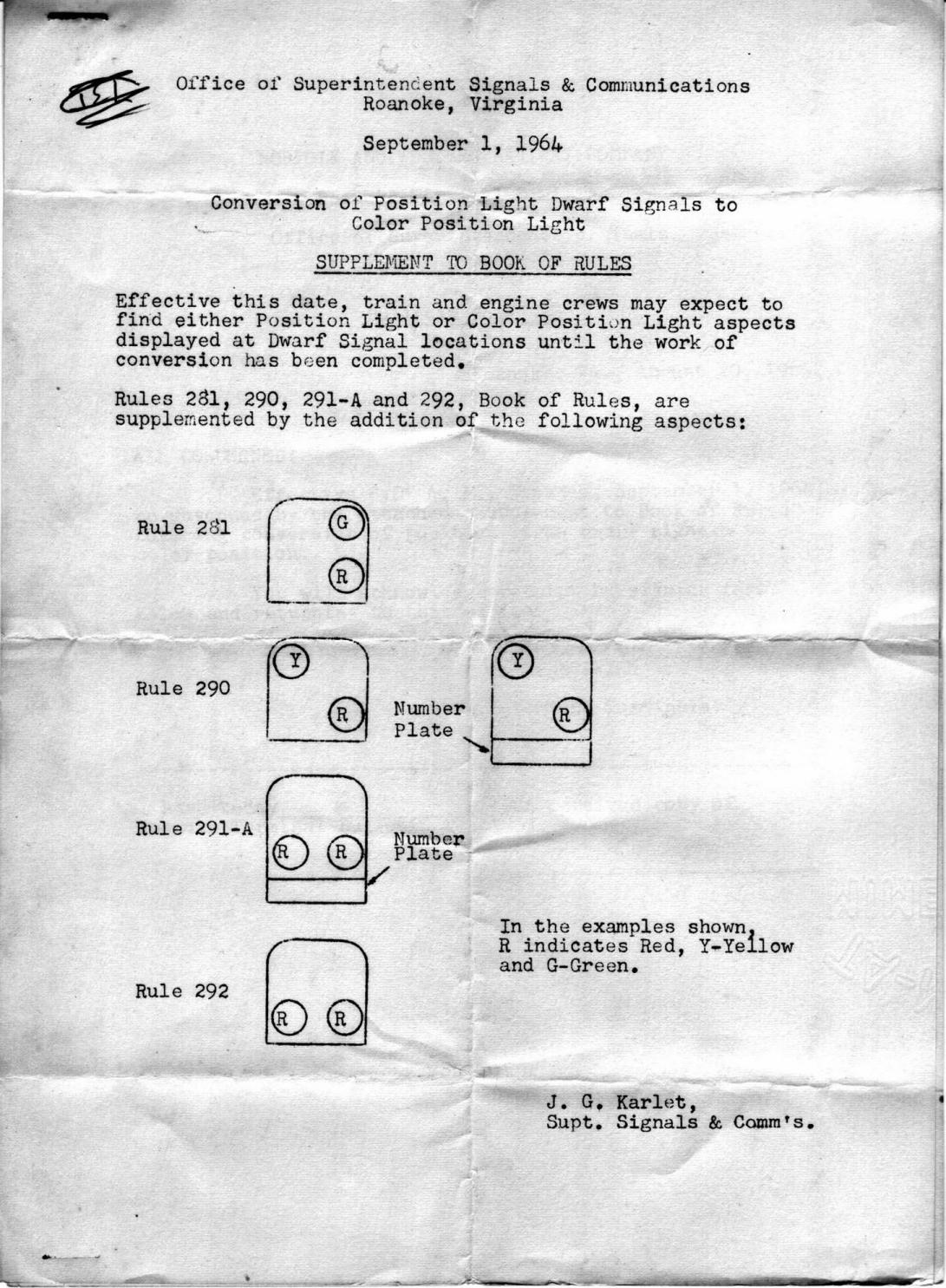
Here are some comments regarding the conversion process, which does appear to be very well documented in the annuls of railway signaling. These are all personal comments and observations which appeared during 11/2012 on the Yahoo Railway Signaling group.
>>I do have a related question which I hope someone can answer. You mention the number
plates were removed from the absolute signals sometime during the '70's.
Was this about the same time N&W
converted to the 2-light color
indications as well? I have seen
pictures taken in the late '60's with the 3
amber indications and later with color indications.
>>The number and S plates on absolute signals were removed between late 1971 and late 1973 based on employee timetables. The Stop aspect without the plates was shown in the timetable as a change to the aspect shown in the rule book. I didn't see it in the 1971 timetables for the ex-N&W divisions, but it does appear in Norfolk Division No. 5 dated November 11, 1973.
>>I doubt any non-colorized position signals lasted anywhere near as late as 1981; they just weren't around later than that based on rule books. My impression is that most of the conversions happened in the 1960's because the N&W did a lot of signal work during that period. I'd say the vast majority, if not all, had been completed by the 1973 date above.
>>Thank you all for the information. I have to say I am somewhat surprised that the changes weren't complete until around 1981. Of course, I realize there are budgets involved as well as time so I suspect the work was probably performed/completed by division.
>> I believe the first trials for the
colorized aspects were in the very late 1950's. The new aspects started to
appear in employee timetables soon
after; the earliest I've seen with them is
dated 1960. They were shown in the timetables until 1967, when a new rule
book was issued that showed both the traditional all-yellow position signal
aspects and the new two-light colorized aspects. The number plates
and S plates were still shown in that 1967 rule book for absolute signals.
My mid-1970's date for deleting those plates is based on memory from
employee timetables that showed the new nonconforming aspects without the
plates (I'll have to pull a few out to
get a specific date).
>> I think the colorization effort
continued into the early 1970's but was completed by 1981 for sure because
only the colorized aspects are shown in the 1981 rule book. The N&W did a lot
of signal work in the 1960's and 1970's and it's quite possible the
elimination of the number and S plates
on absolutes came about during that work
as a cost savings and standardization measure.
Additional Information
As usual, while trolling the internet for one thing, I invariably come across other information which may or may not be useful. In this instance, I came across some info by Abram Burnett, who is a PL signal expert due to his employment with both the N&W in Roanoke, and the PRR in the Harrisburg area. So here goes:
Questions:
1. What was the manufacturer(s)/make(s)/model(s) for the semaphore signals that predated the position light signals on the N&W?
2. What was the manufacturer(s)/make(s)/model(s) for the position light signals on the N&W?
3. Can anyone point me to good references on placement of signals either in general or N&W specific?
Answers:
From observation, the N&W installed Union Switch & Signal Model PL-2 ("PL" for "position light") for home and automatic block signals.
The PL-2's are distinguishable by the short 10" hood ("visor") and the lamp access side plates held on by single set-screw. US&S later (and last) version of the PL signal was the PL-3, which is distinguishable by longer 14" hoods and two bolts holding on the lamp access side plates. The optics were also improved marginally in the PL-3, but the color and design of the "angel tit" conical coverglass was not changed. The PL-3's were being sold by the mid-1930s.
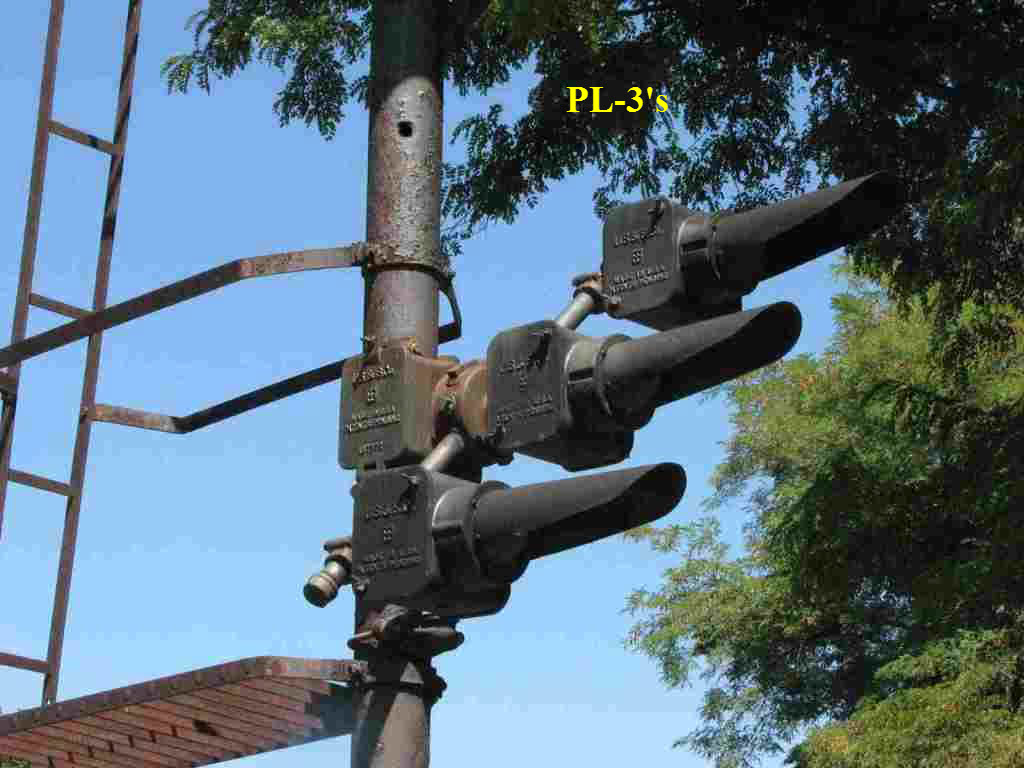
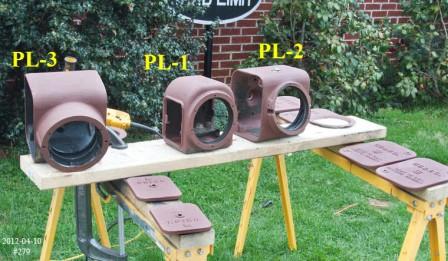
Now, as for the dwarf signals, there are also two styles. Based on a check of US&S catalogues which I just made, US&S did not distinguish the two types of dwarfs by numbers, but simply called them "old style" and "new style." The difference in the old and new styles is how one accesses the lamps. The old style had side plates on the left and right sides, and re-lamping one of them really chews up the knuckles. On the new style, the entire back of the signal is removed to gain access to the lamps. The new style PL dwarf was available around 1930.
Another variation in the dwarf signals is the quadrant of the arc. On the old style signals, the quadrant was in the 12 o'clock-3 o'clock quadrant. On the new style dwarfs, the quadrant is in the 9 o'clock-12 o'clock quadrant. The reason for this change occurred on the Pennsylvania RR, the biggest user of PL signals. With the old style PL dwarfs, there was inadequate clearance between the cylinders of the newer, larger engines and the top of the dwarf signals, and the newer engines would sometimes clip them off. Therefore, the quadrant of the arc was changed from the 12-3 o'clock quadrant to the 9-12 o'clock quadrant.
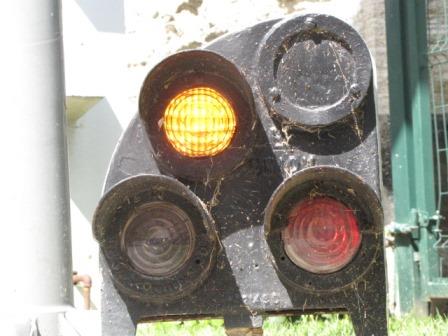 "NEW" Style
"NEW" Style
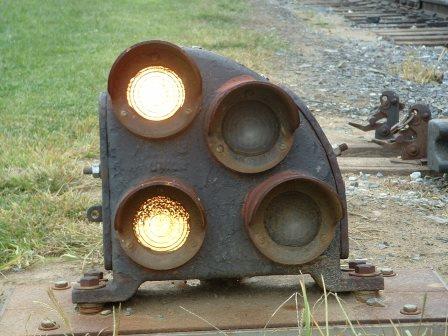 "OLD" Style
"OLD" StyleHopefully someone will someday do a good research paper on the N&W's development and application of the PL signal. What is amazing is that "parent" PRR had a really good system of aspect logic worked out for the PL signals, but N&W chose to use US&S's signal hardware but develop its own signal "logic."
Two examples:
1) Those beautiful 3-arm (yes, three !) PL signals that we see in photographs of the 1940s-early 1950s on the Radford and Pocahontas Divisions.
(2) The fact that N&W used, on its dwarfs, rows of lights in both the "/" and the "\" directions to indicate "Restricting." the N&W could have saved itself a lot of money if it had adopted what the PRR had already perfected, instead of fiddling around. In my humble opinion, N&W's signal people were country boys who thought they didn't need the sophistication employed on a 4-track, fast railroad.
The N&W began installing colored roundels (green or red, as required) in both high and dwarf signals about 1960-61. Before that, all lenses on high signals were "noviol" (meaning "no violet") yellow, and all lenses on PL dwarfs were clear, backed up with a sandblasted flat glass diffuser disc.
In 1981 or 1982, the PRR Tech & Historical Society published an excellent article in its journal, The Keystone, on the history of the development of the PL signal. I might be able to find a photocopy for you.
As for signal placement, that's easy. (Take it from one who was involved in this stuff professionally for years, albeit on another railroad.) Home signals are placed at the entrances to interlockings, and automatics are placed based on (1) braking distance to the next signal while running at maximum authorized speed, and (2) good "preview" for the engineman.
And finally... Don't ever let any jack-leg tell you that signals have "heads." They don't! One properly speaks of "arms" on a signal, e.g. "top arm," "bottom arm," "middle arm." Those technical nomenclatures apply to semaphore signals, PL signals and CL (color light) signals equally.
Interesting that you should post this question this evening... I just came in from re-lamping an N&W signal that's in the back yard!
Additionally, he added:
I should have added something on usage of the various types of signals. I'll try to make this simple, and assume you are talking 1950s of later (i.e., when the two arm home signals had come into use, rather than three arm.)
I'll start with two definitions.
A "Home Signal" is always controlled by a lever operated by the operator or train dispatcher. It may be either a high signal or a dwarf signal, depending on how much sight distance is needed (i.e. based on the speed at which trains will be approaching.)
An "Automatic Block Signal" is not controlled by a lever, but "does its thing" based exclusively on the conditions of block occupancy ahead.
Automatic Block Signals are always high signals, because they govern trains approaching at track speed and thus greater sight distance is needed, and may mounted either on a ground mast or on a signal bridge. Generally, they give indications of "Clear" (the track is clear for two blocks,) "Approach" (track is clear for one block only, so approach the next signal prepared to stop,) or "Stop and Proceed" (block is occupied.)
Here's a rule of thumb: For Home Signals, the most restrictive indication is Stop. For Automatic Block Signals, the most restrictive indication is Stop and Proceed.
So, which signals have two arms, and which have only one arm? To make it simple, most high Home Signals on the N&W were two arm signals. Most Automatic Block Signals were one arm. The one place you would/will find Automatic Block Signals having two arms is when they are the "distant signal" to an interlocking and have to give an indication requiring "approach the next signal at medium speed" or "approach the next signal at slow speed."
Dwarf signals have always been used where moves will be approaching at "slow speed" (defined as 15mph,) which means that they don't need great sight distances to be able to comply with a stop indication. Dwarfs were generally used in Rule 251 territory (one direction automatic block signaling on a track) for trains running against the current of traffic. By rule, trains running against the current of traffic were required to approach all home signals prepared to stop, so a dwarf would suffice. N&W also had an interesting practice of peppering dwarf signals within big, complex interlockings (like Randolph Street, Roanoke,) and at such places a train might need to get two or three or four favorable signals to "get through" an interlocking, from one end to another. The reason for placing multiple dwarfs at places like that is, in technical lingo, "trailing release circuits".... That is, the train only has to clear part of an interlocking, not the whole thing, before switches release and can be lined for another movement. Dwarf signals are almost universally "home signals."
Signal Variations
Upper Head Variations
The basic N&W signal consists of an upper head with a full round background, and a single lower lamp below, as shown in the set directly below. This set shows stop, approach, and clear.
The upper head can have one, two, or three positions. Restrict is indicated on the lower head, that is why there are only three possible aspects on the upper head.
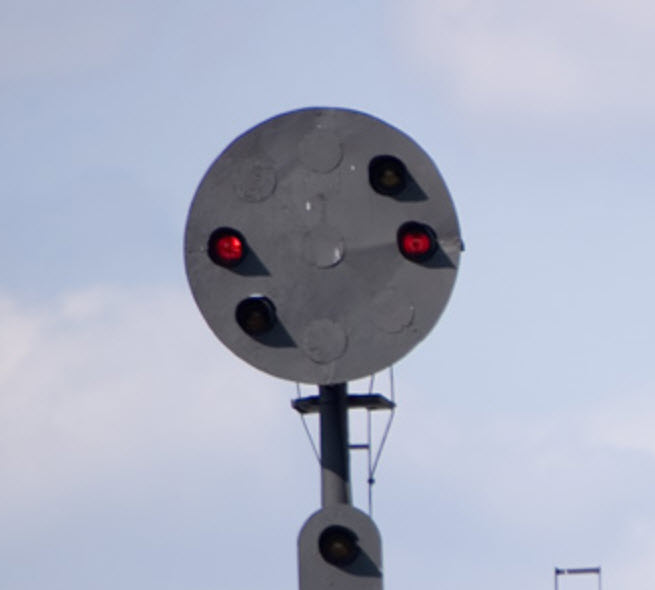
Lower Head Variations
The lower head can be anything from a single lamp, used in conjunction with the upper head to display stop, to one with four aspects. Most lower heads, except for the single lamp, have a full background - the signal to the right is the only signal I have seen without a background, and displays the same aspects as the one next to it. The first picture is a two aspect head, since the center lamp is used for the stop indication.
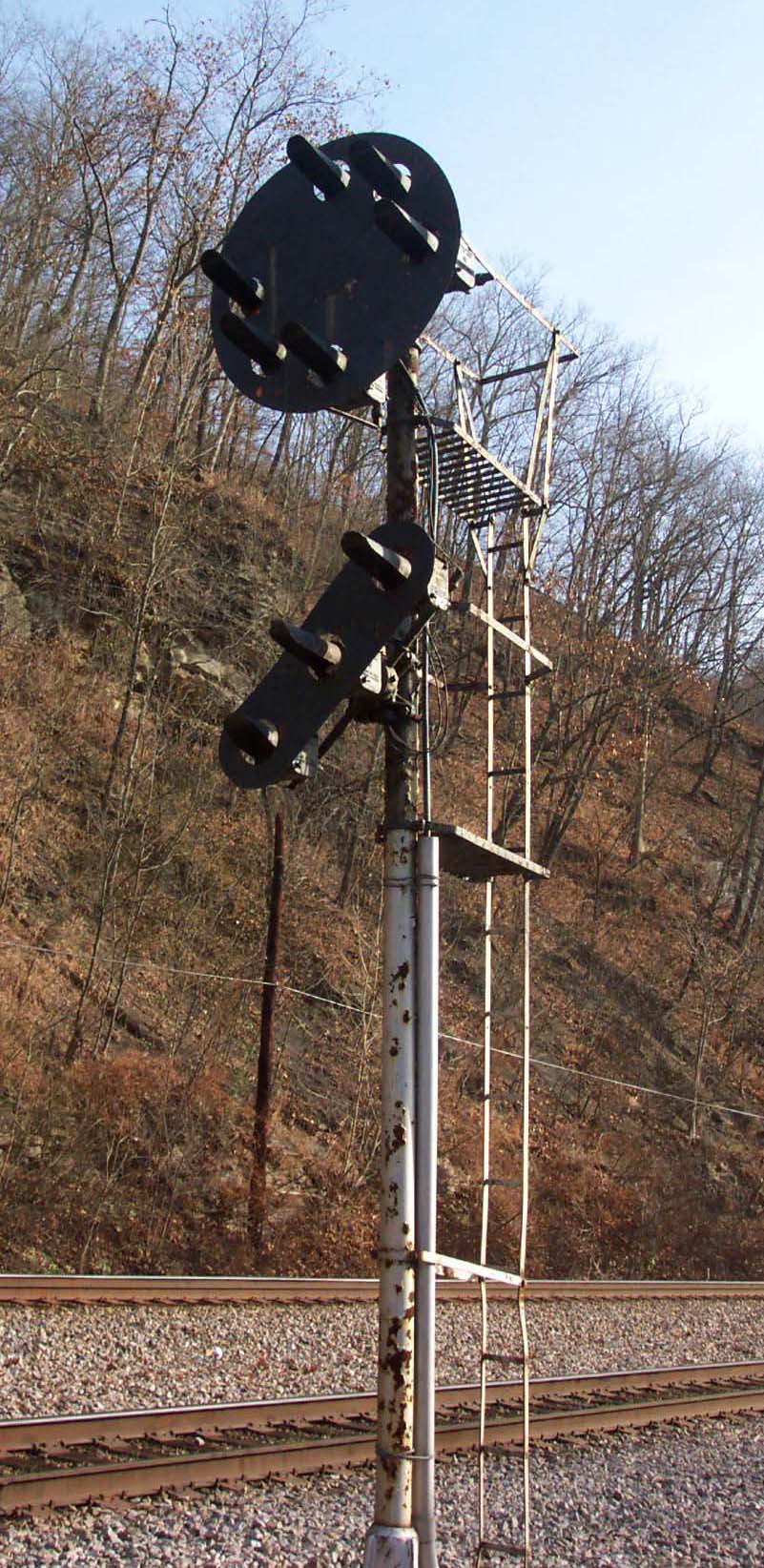
One example of a two aspect lower head with a partial background, on the Columbus OH District. Photo by Larry Evans.
Here are close-ups of a nicely restored PL-4 dwarf by
Eric Davis:
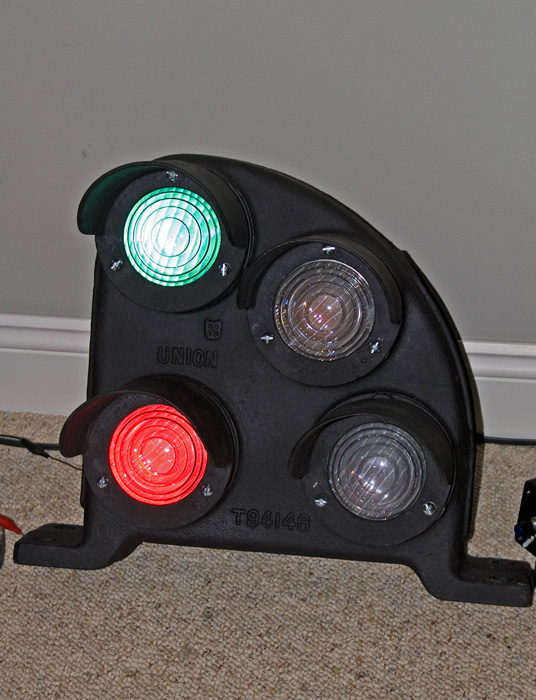
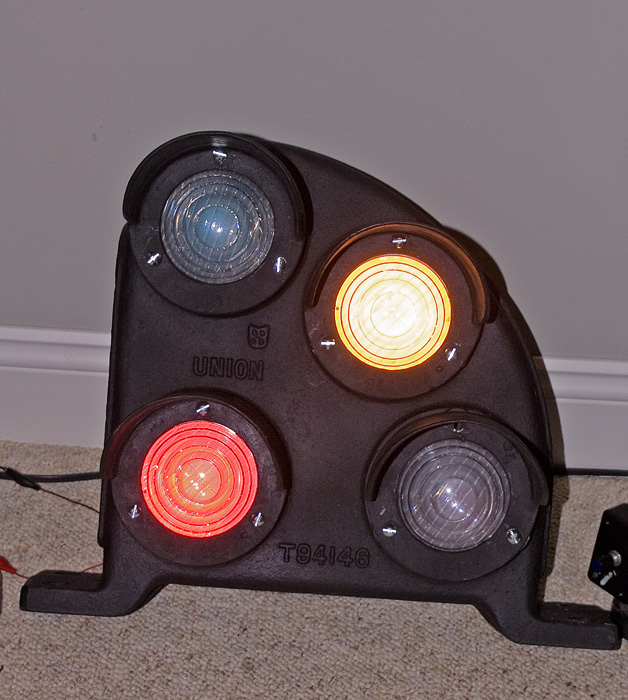
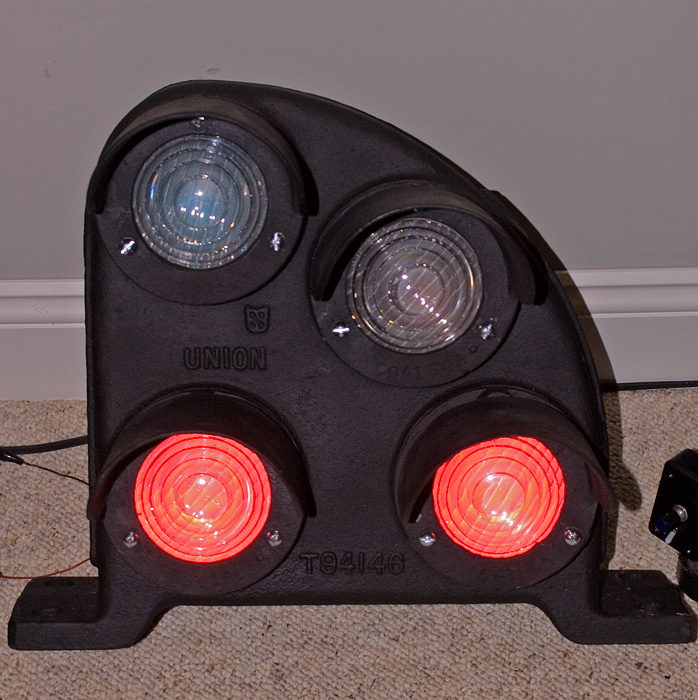
N&W CPL signals are mounted the same as any other signal, there are just more variations of them around, like the Pennsy PL signals. This is a small sampling of what you'll find.
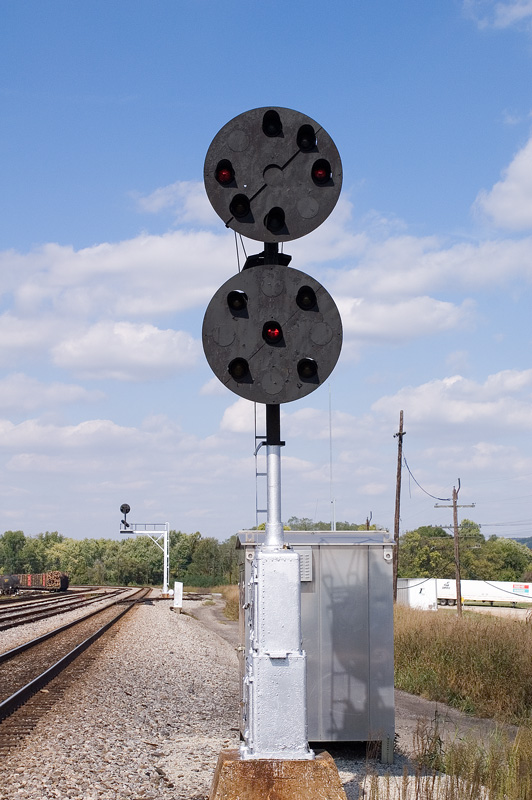
An absolute signal, mast mounted on top of an equipment cabinet.... at Southern Ave in Chillicothe OH. Photo by Eric Davis.
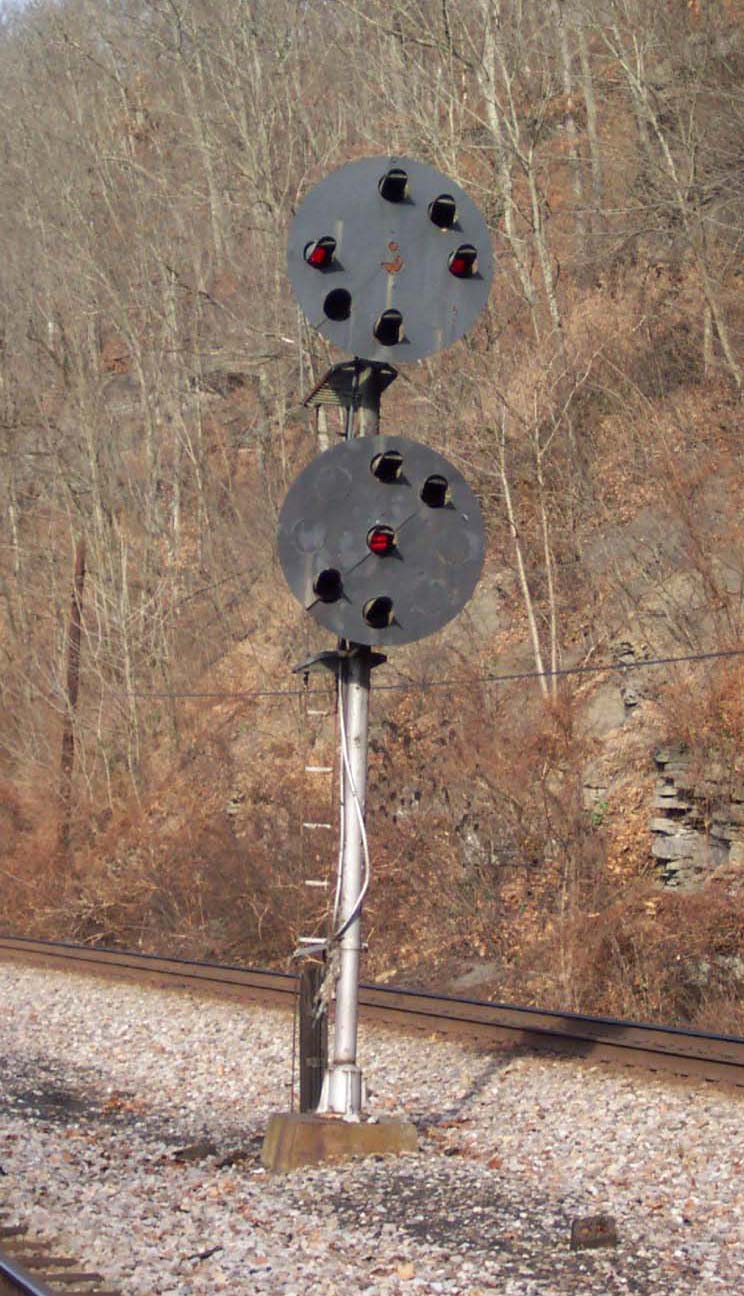
A mast mounted high signal elsewhere in Ohio, photo by Larry Evans.
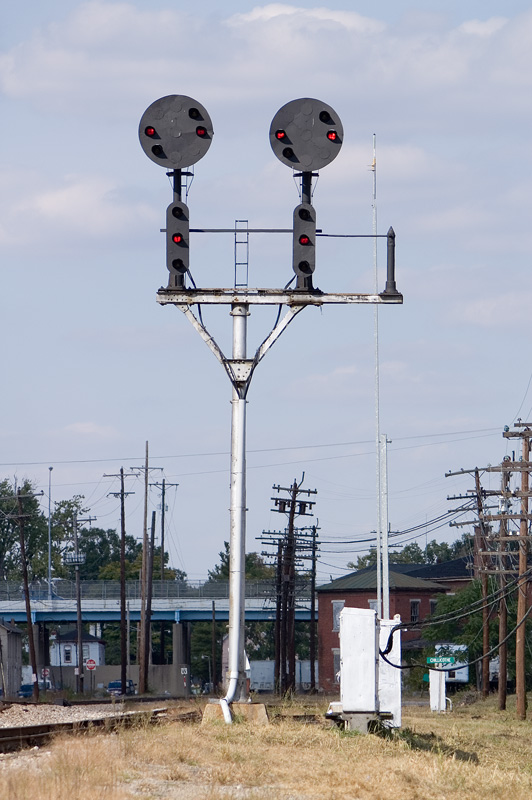
A pair of bracket mounted signals in Chillicothe... notice the doll post and partial backgrounds! Photo by Eric Davis.
A cantilever mounted signal in Roanoke VA.
One version of a signal bridge, also in Roanoke VA.
From NS Timetable #3, Eastern Region, Virginia Division, effective Sunday, September 6, 1992
Map is of the Eastern Region, Virginia Division
Rulebook scans courtesy John C Henderson
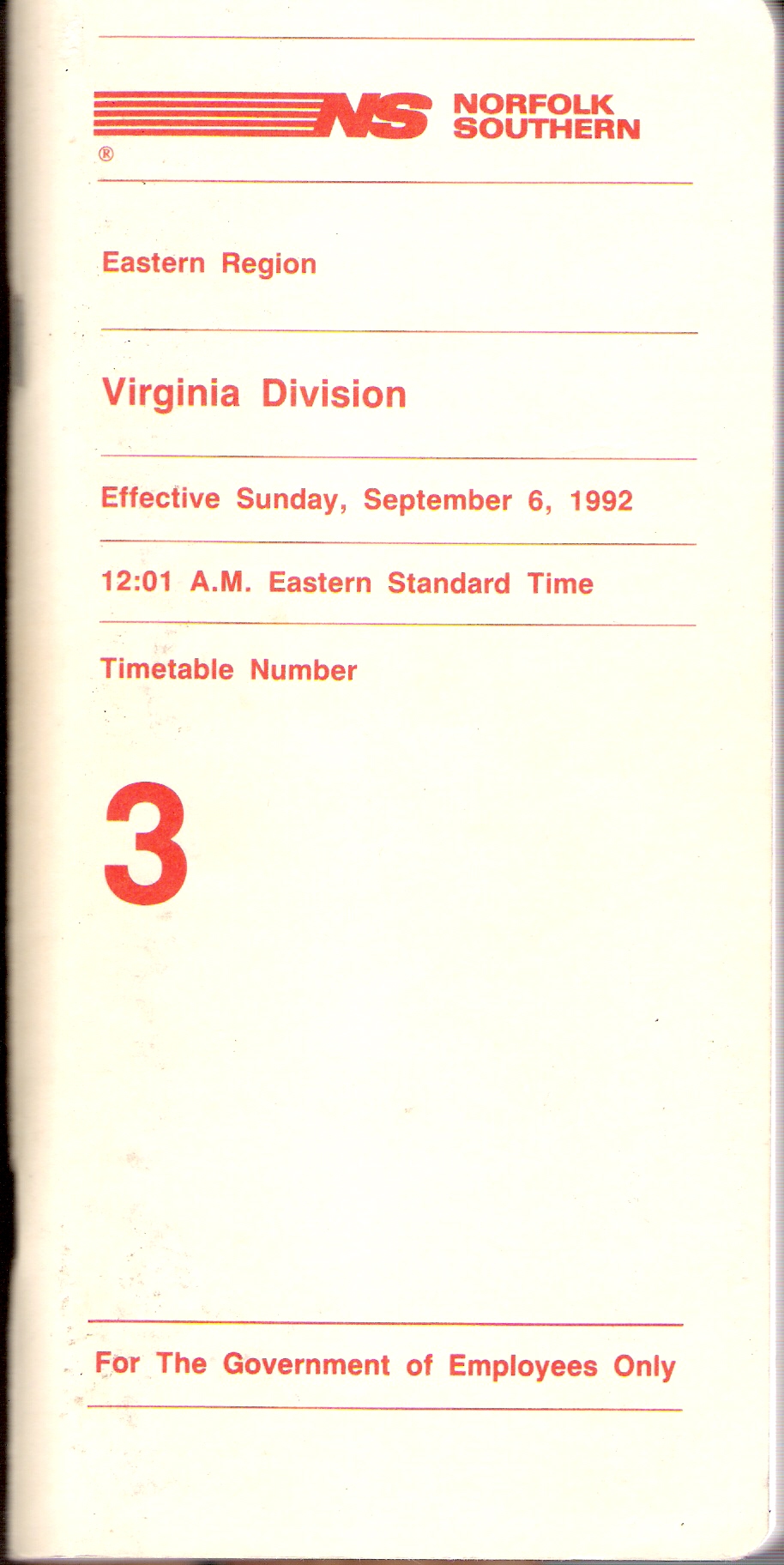
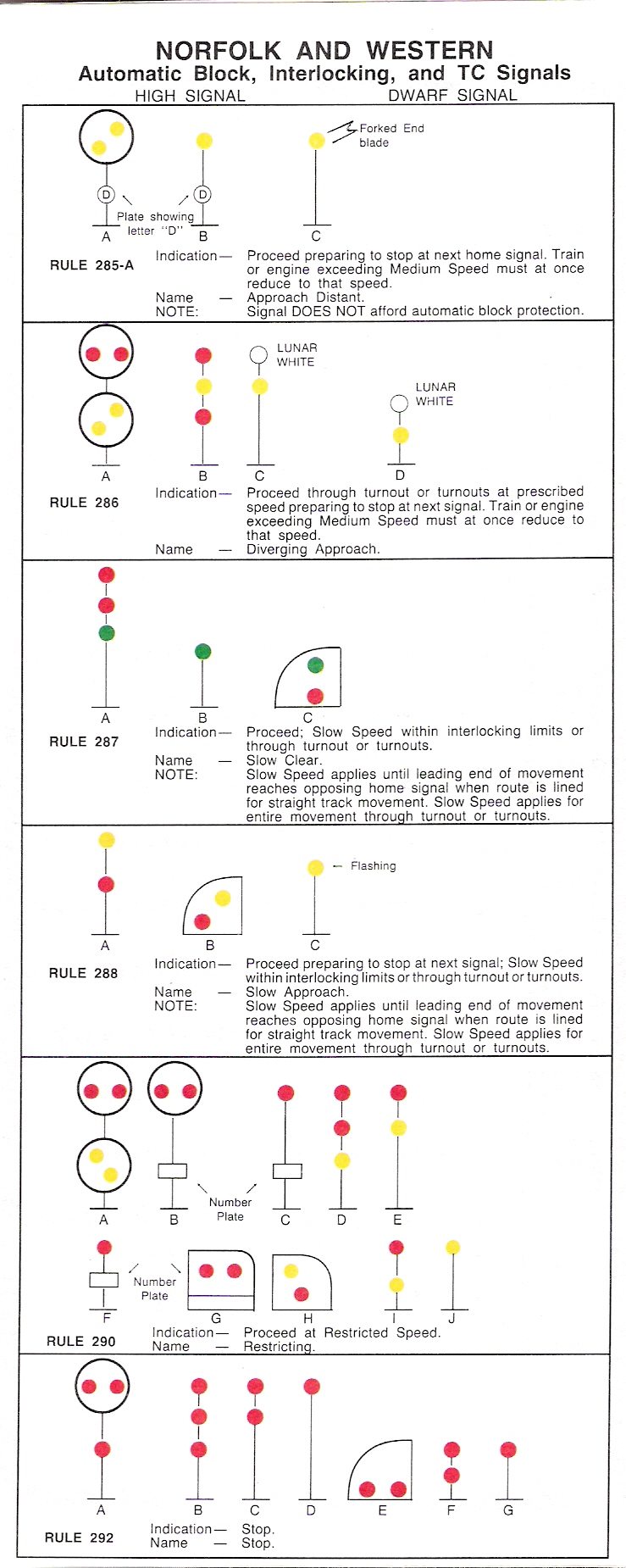
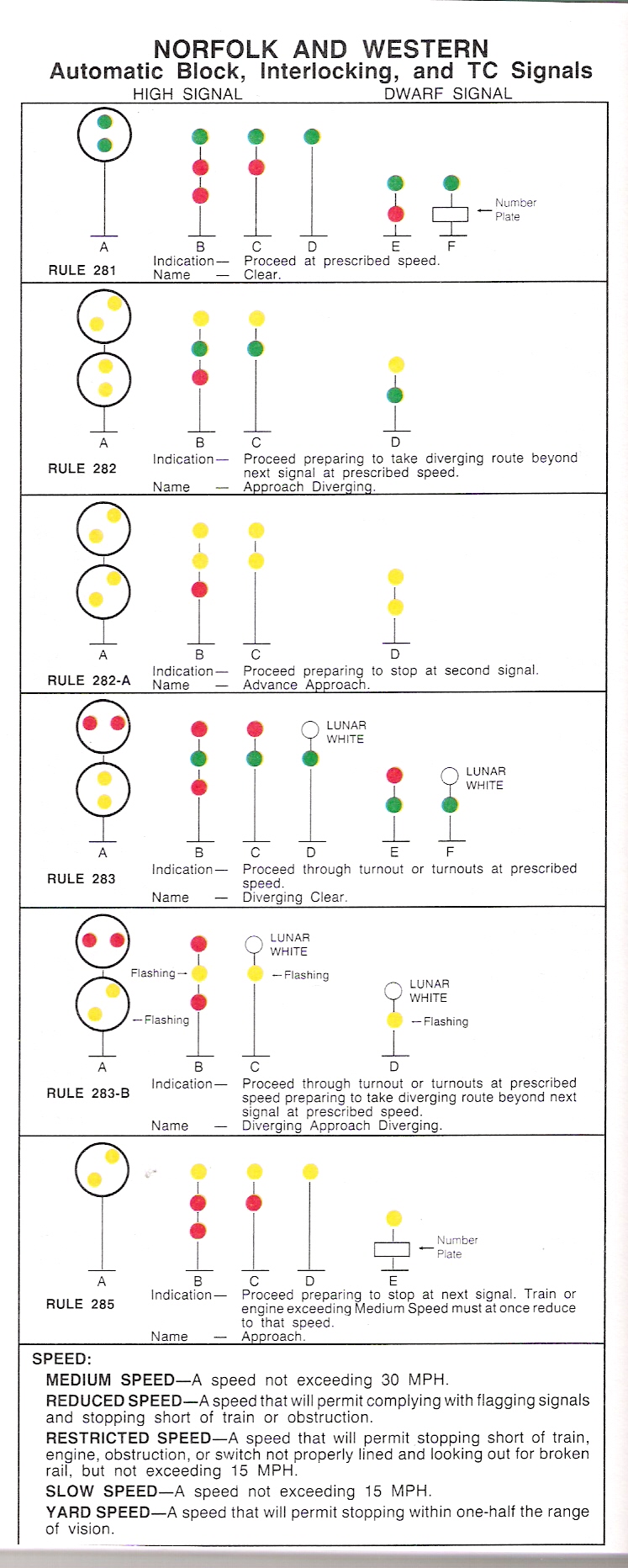
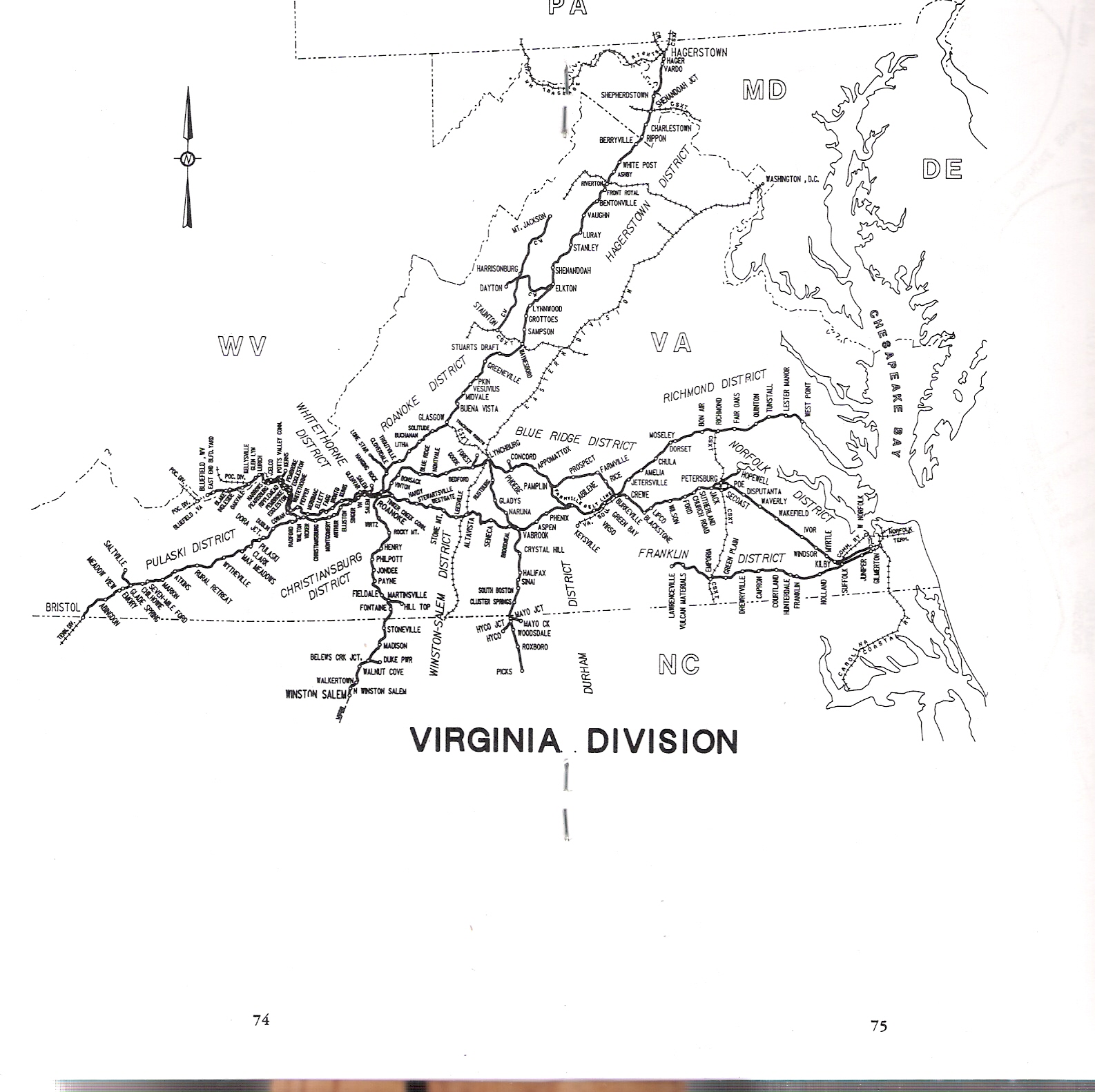
Belews Creek Spur NC These signals are the only N&W CPL's that
remain on NS's Winston-Salem District, all of the other signals on the
mainline have been replaced with Safetran colorlight signals. Pictures
by Joseph Norton who has been documenting signals in and around North
Carolina. More of his pictures are
here and
here. Located in downtown Roanoke is an especially nice
display the Norfolk Southern and many others erected to dedicate the fact
that the railroad made Roanoke the town it is today. One of the
displays is a signal display, showing both an original N&W all yellow signal
head, and a colorized version. The aspect can be changed by visitors
using a switch mounted next to a plaque describing the signals.
Berryville is on the line running from
Manassas VA to Front Royal VA, where it joins up with the line between
Roanoke and Hagerstown MD. The signal on the south, or west side where
it is single track has already been replaced with a set of colorlights. Bedford is about 25 miles east of Roanoke.
This signal location is on the east side of town. Bedford is also home
to the Liberty Restaurant, a converted N&W station that last saw passengers
the day Amtrak took over. Notice the siding is to the left, hence, the
left signal is lower. Comparing this set to others, the offset is not
as great. Also located in town is the National D-Day
Memorial, and I have to tell you, if you never go to see but one in your
life, I highly recommend this one. They did a most fantastic job! Disclaimers: New: SEP19/2009, DEC20/2016,
OCT15/2018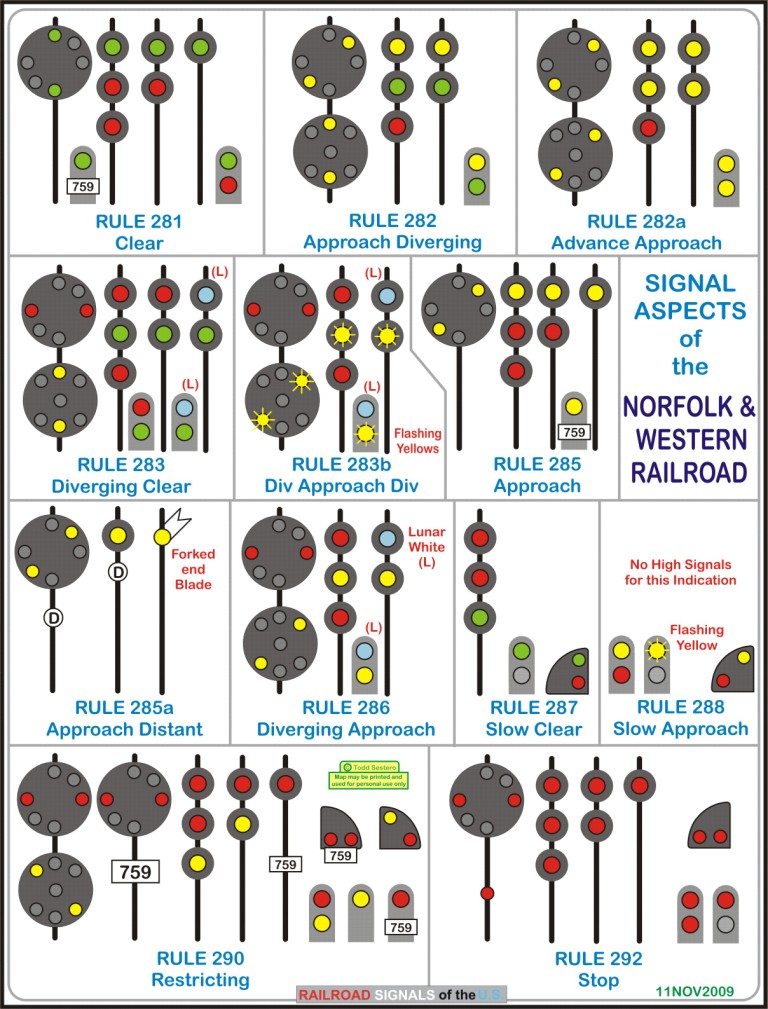
A one page reference sheet for the N&W signals, available
here as a PDF.
Notice that the same CPL dwarf can not display both rule 288 and 290 unless
it uses a number plate.
Railwalk - Roanoke VA
Roanoke VA
Berryville VA
Bedford VA
Glasglow VA
PLEASE NOTE: Since his page was originally done in 2009,
MOST, if not all of these CPL signal locations have been replaced with Color
Light Signals.
The three main aspects shown in the original all yellow
format.
The same aspects shown in the colorized version. Too bad the bottom lamp isn't working for the STOP indication.
Roanoke is WAS CPL heaven, but they were all replaced in 2012 (in addition to some track realignment). I would like to
thank my wife Dianne for her patience in getting these pictures in Roanoke, Glasgow, and Berryville on our way home from Atlanta.
Another change that has been recently brought to my attention, as of October 2018, is that most of Railwalk has been torn up due to the expansion and remodeling of
the Amtrak Station :-(
Thanks to Richard K and James L for updates in this section!!

This map keys the photos below to their location in the downtown Roanoke area.
![]() This pair of signal bridges is located along Campbell Ave NE, east of the interstate and the wye.
This pair of signal bridges is located along Campbell Ave NE, east of the interstate and the wye.
![]() Signal bridge along Campbell, a little west of the above location.
Signal bridge along Campbell, a little west of the above location.
![]() Also along Campbell is this single signal.
Also along Campbell is this single signal.
![]() Located within the wye off Campbell is this bracket post with a set of signals.
Located within the wye off Campbell is this bracket post with a set of signals.
![]() On the left of the picture on the left above at 4, is a colorlight signal that replaced this CPL signal.
Notice the lower head does not have a background, just as in some Pennsy PL signals.
On the left of the picture on the left above at 4, is a colorlight signal that replaced this CPL signal.
Notice the lower head does not have a background, just as in some Pennsy PL signals.
![]() Along Shenandoah, is the Park Street Tower, and this set of signals is adjacent to it. Notice one of the
PL dwarfs has been replaced by a colorlight signal... this is often done when a wreck wipes out the older signals. The four on the right are from 2004.
Along Shenandoah, is the Park Street Tower, and this set of signals is adjacent to it. Notice one of the
PL dwarfs has been replaced by a colorlight signal... this is often done when a wreck wipes out the older signals. The four on the right are from 2004.
![]() Signal bridge near Norfolk and Jefferson Streets
Signal bridge near Norfolk and Jefferson Streets
(maybe we can call it a combination signal and cantilever bridge?) How about that collection of wires coming out of the equipment cabinet!
![]() These signals used to be mounted on the ex 1st St SW overpass as seen in the other
photos. It was a great place for close-ups.
These signals used to be mounted on the ex 1st St SW overpass as seen in the other
photos. It was a great place for close-ups.
![]() Not readily seen from vantage points east of the dwarf, it can be clearly
seen from this shot taken by Park Street. It's showing a slow clear.
Not readily seen from vantage points east of the dwarf, it can be clearly
seen from this shot taken by Park Street. It's showing a slow clear.
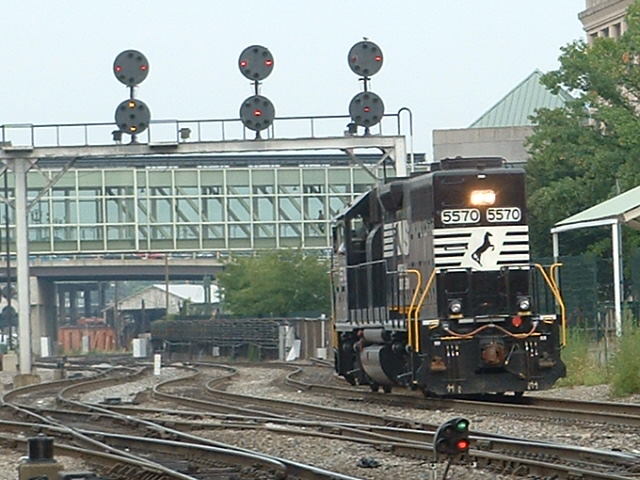
![]() These signals are at the south end of the wye that sits off Campbell. One of the three signal locations
has had it's CPL signals replaced with a colorlight installation. Looking thru the underpass you can see the colorlight signal along Campbell that fairly recently
replaced a CPL, the bracket signals behind it are shown above at 4. These pictures were taken from 3rd St SE... There is a tire place at 3rd and Campbell where you
can park for a while to take pictures here. I threw in the pix of the Dr Pepper sign for fun, you don't see it "advertised" like that much.
These signals are at the south end of the wye that sits off Campbell. One of the three signal locations
has had it's CPL signals replaced with a colorlight installation. Looking thru the underpass you can see the colorlight signal along Campbell that fairly recently
replaced a CPL, the bracket signals behind it are shown above at 4. These pictures were taken from 3rd St SE... There is a tire place at 3rd and Campbell where you
can park for a while to take pictures here. I threw in the pix of the Dr Pepper sign for fun, you don't see it "advertised" like that much.
Glasgow is off I81 at exit 175, and is about 30 miles north of Roanoke. This is just one of the signals in town, as there is a wye
here. The tracks coming off the wye and heading east go through some very pretty country following the James River. Also off the exit is
the Natural Bridge.
I love trains, and I love signals. I am not an
expert. My webpages reflect what I find on the topic of the page.
This is something I have fun with while trying to help others.
If this is a railfan page, every effort has been made
to make sure that the information contained on this map and in this railfan
guide is correct. Once in a while, an error may creep in :-)
Beware: If used as a source, ANYTHING from Wikipedia must be treated as
being possibly being inaccurate, wrong, or not true.
My philosophy: Pictures and maps are worth a
thousand words, especially for railfanning. Text descriptions only
get you so far, especially if you get lost or disoriented. Take
along good maps.... a GPS is OK to get somewhere, but maps are still
better if you get lost! I belong to AAA, which allows you to get
local maps for free when you visit the local branches. ADC puts
out a nice series of county maps for the Washington DC area, but their
state maps do not have the railroads on them. If you can find em,
I like the National Geographic map book of the U.S..... good, clear, and
concise graphics, and they do a really good job of showing you where
tourist type attractions are, although they too lack the railroads.
Other notes about specific areas will show up on that page if known.
Pictures and additional information is always needed if anyone feels
inclined to take 'em, send 'em, and share 'em, or if you have
something to add or correct.... credit is always given! BE NICE!!! Contact info
is here
Beware: If used as a source, ANYTHING from Wikipedia must be treated as
being possibly being inaccurate, wrong, or not true.
RAILFAN GUIDES HOME
RAILROAD SIGNALS HOME
Last revised
11/25/2019
